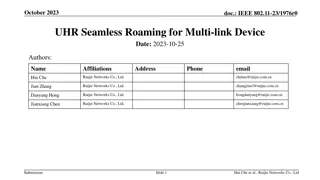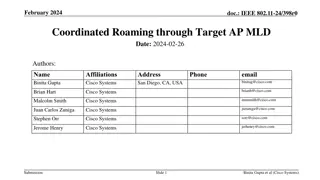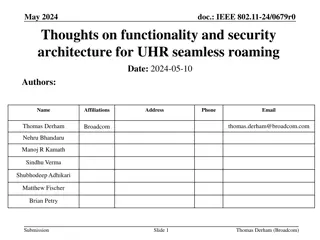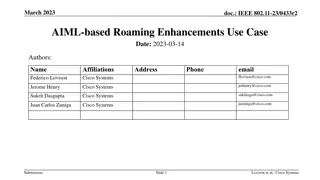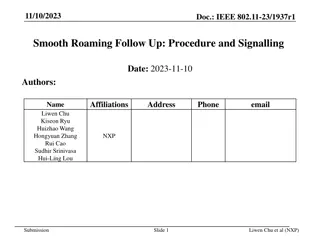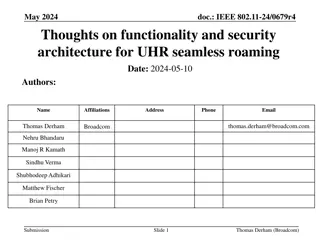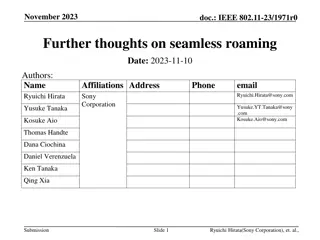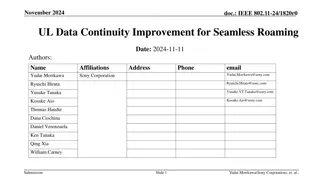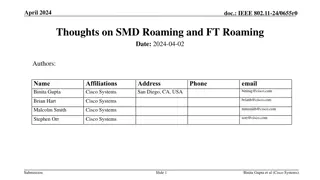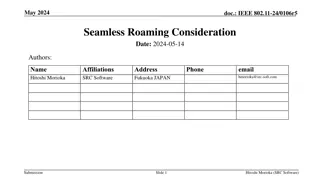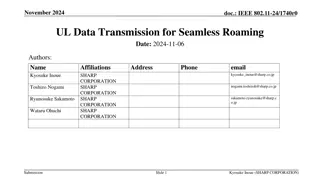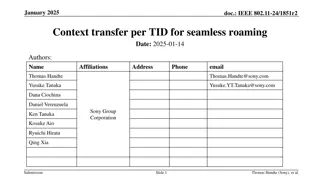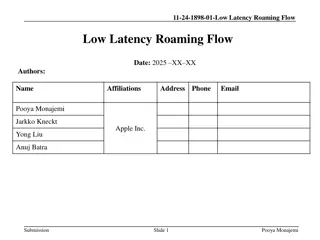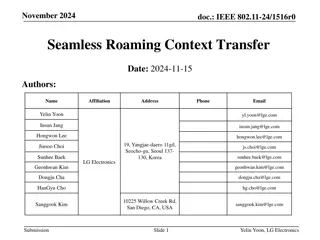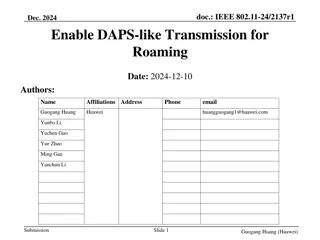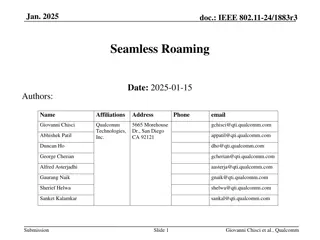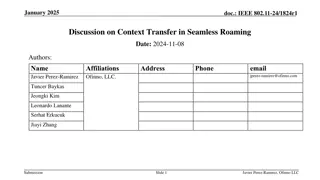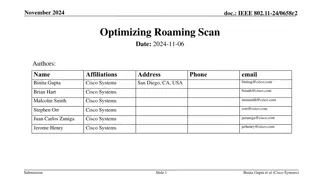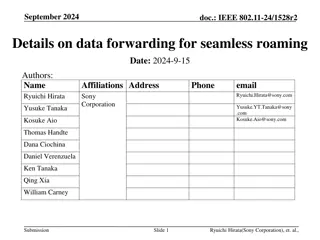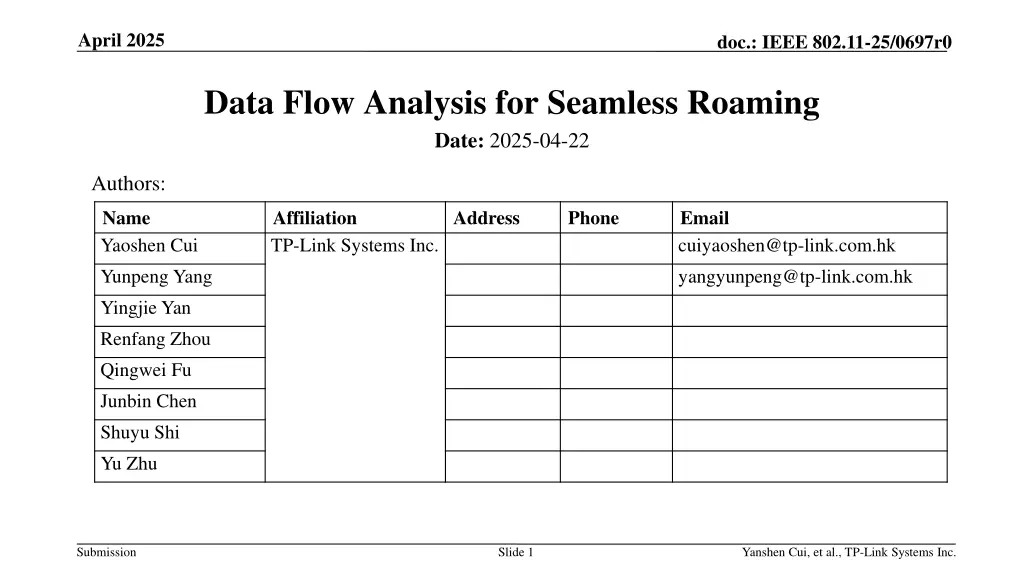
Data Flow Analysis for Seamless Roaming
Explore IEEE 802.11-25/0697r0 data flow analysis for seamless roaming procedures, including context transfer, data forwarding, and roaming behaviors per TID on AP MLD. Detailed insights provided by Yaoshen Cui and team from TP-Link Systems Inc.
Download Presentation

Please find below an Image/Link to download the presentation.
The content on the website is provided AS IS for your information and personal use only. It may not be sold, licensed, or shared on other websites without obtaining consent from the author. If you encounter any issues during the download, it is possible that the publisher has removed the file from their server.
You are allowed to download the files provided on this website for personal or commercial use, subject to the condition that they are used lawfully. All files are the property of their respective owners.
The content on the website is provided AS IS for your information and personal use only. It may not be sold, licensed, or shared on other websites without obtaining consent from the author.
E N D
Presentation Transcript
April 2025 doc.: IEEE 802.11-25/0697r0 Data Flow Analysis for Seamless Roaming Date: 2025-04-22 Authors: Name Yaoshen Cui Yunpeng Yang Yingjie Yan Renfang Zhou Qingwei Fu Junbin Chen Shuyu Shi Yu Zhu Affiliation TP-Link Systems Inc. Address Phone Email cuiyaoshen@tp-link.com.hk yangyunpeng@tp-link.com.hk Submission Slide 1 Yanshen Cui, et al., TP-Link Systems Inc.
April 2025 doc.: IEEE 802.11-25/0697r0 Introduction During seamless roaming, context related to non-AP MLD can be transferred to target AP MLD during roaming preparation and/or execution procedure [1]. Preparation Transfer or renegotiation of the context to a target AP MLD Execution Transfer the context that is required for enabling operations with the target AP MLD Non-AP MLD can request to the current AP MLD what context needs to be transferred from the current AP MLD to the target AP MLD [1]. Non-AP MLD decides whether dynamic parameters of BA session per TID need to be transferred. Submission Slide 2 Yanshen Cui, et al., TP-Link Systems Inc.
April 2025 doc.: IEEE 802.11-25/0697r0 Recap: Seamless Roaming Procedures SMD Discovery Non-AP MLD collects neighbor AP MLDs capabilities via current AP MLD for better roaming decisions. Capabilities including MLD level capabilities and SMD level capabilities. Roaming preparation Non-AP MLD send preparation request(s) to current AP MLD Current AP MLD assists non-AP MLD in completing: Setup links with candidate target AP MLD(s) Static context transfer to candidate target AP MLD(s) Roaming execution Notification of DS mapping update. Dynamic context transfer to maintain data exchange continuity. on AP MLD rrent AP MLD arget AP MLD Data e change ith c rrent AP MLD Discover Preparation e est onte t rans er Preparation esponse oa ing e est onte t rans er D apping p ate oa ing esponse Data e change ith c rrent AP MLD Submission Slide 3 Yanshen Cui, et al., TP-Link Systems Inc.
April 2025 doc.: IEEE 802.11-25/0697r0 Motivation TGbn has agreed context transfer and data forwarding between AP MLDs during roaming procedures to maintain the consistency of BA operation. To keep consecutive BA operation from current AP MLD to target AP MLD, Data forwarding is necessary to avoid packet drop at L1/L2 layers. Both static and dynamic BA context transfer during preparation and execution, respectively. Target AP MLD keeps consecutive BA operation from current AP MLD after roaming response. In this presentation, we provide detailed data flows analysis for seamless roaming combining dynamic BA context transfer and data forwarding. Submission Slide 4 Yanshen Cui, et al., TP-Link Systems Inc.
April 2025 doc.: IEEE 802.11-25/0697r0 Roaming Behaviours per TID on AP MLD rrent AP MLD arget AP MLD After successful preparation, target AP MLD establishes BA agreements with non-AP MLD in advance. Non-AP MLD sends a roaming request with DL data forwarding and dynamic BA context transfer requirements for specific TIDs. DL ith c rrent AP MLD L ith c rrent AP Preparation e est tatic onte t rans er stablish A agree ents in a vance Preparation esponse For those TIDs with above requirements, there is an DL suspension to froze and transfer dynamic parameters of current BA sessions. Target AP MLD continues a consistent BA operation after roaming response. For those TIDs without above requirements, current AP MLD continues transmitting until roaming response, and then discards the remaining data. Target AP MLD resets a new BA operation after roaming response. rrent AP MLD l shes all L ata to net or oa ing e est re ire ata or ar ing DL s spension L s spension D na ic onte t rans er ontin e A sessions o c rrent AP MLD DL Data or ar ing ith assigne s oa ing esponse DL ith target AP MLD L ith target AP MLD DL L Data e change ith c rrent AP MLD (* Current AP MLD flushes all UL data to network when receiving roaming request [2].) Submission Slide 5 Yanshen Cui, et al., TP-Link Systems Inc.
April 2025 doc.: IEEE 802.11-25/0697r0 Data Flow Analysis for Consecutive BA Operation (1/2) When receiving roaming request, current AP MLD stops DL (for specific TIDs) to freeze the dynamic BA status (Next SN, etc.). Dynamic context transfer is executed to transition the dynamic BA status to target AP MLD. Meanwhile, data forwarding is initiated, with assigned SN of each MSDU or A-MSDU. Target AP MLD transmits DL data from next SN on after roaming response. When finishing forwarding, there is an end indication (i.e. more data=0). After receiving which, target AP MLD can assign SNs to new DL data from DS. rrent AP MLD arget AP MLD on AP MLD D Deliver DL ata to c rrent AP MLD stablish A agree ents in a vance Preparation ith static A conte t trans er oa ing e est re ire ata or ar ing or speci ic Ds top DL or speci ic Ds D na ic onte t rans er e t assigne s ere ata or ar ing ith or ar DL ata in b er L s spension DL s spension or speci ic Ds D apping p ate MLD Deliver DL ata to target AP e DL ata ro D oa ing esponse tart DL ro ne t ontin e A sessions o c rrent AP MLD DL ata or ar e n or ar ing ata e DL DL L Data e change ith c rrent AP MLD An example of detailed data flows and context transfer is illustrated below. Submission Slide 6 Yanshen Cui, et al., TP-Link Systems Inc.
April 2025 doc.: IEEE 802.11-25/0697r0 Data Flow Analysis for Consecutive BA Operation(2/2) When receiving roa ing re est, c rrent AP MLD s ost recentl receive A sho s that # =6 is issing an others (before #SN=10) are successfully received by non-AP MLD. Current AP MLD forwards remainder data (including pending data when roaming request and new data from DS before D apping p ate to target AP MLD. Mean hile, conte t trans er is e ec te incl ing e t =6 an stat s o current AP MLD. After roaming response, target AP MLD transmits DL data forwarded data from current AP MLD and new data from DS rrent AP MLD arget AP MLD Data in trans it b er hen roa ing re est Pen ing ata ro D be ore D apping p ate e ata ro D a ter D apping p ate or ar e ata ro c rrent AP MLD Ac e ata 6 6 6 Data elivere to ne t la er trans itte ata ith s ccess l A Data or ar ing onte t trans er e t = 6 6 trans itte ata ith aile A on AP MLDs receiving ti eline Data pen ing to trans ission DL ro c rrent AP MLD DL ro target AP MLD oa ing re est oa ing response Submission Slide 7 Yanshen Cui, et al., TP-Link Systems Inc.
April 2025 doc.: IEEE 802.11-25/0697r0 Summary Dynamic BA context transfer and data forwarding are used to maintain the consistency of BA operation before and after roaming. Non-AP MLD provides data forwarding and dynamic context transfer requirements for specific TIDs in roaming request. Detailed data flows are analyzed in roaming execution procedure. For the TIDs without data forwarding, current AP MLD continues transmitting until roaming response is send. The pending data will be discarded. For the TIDs enabling data forwarding, dynamic BA parameters are transferred to keep the consistency of BA operation from current AP MLD to target AP MLD. DL suspension occurs in execution procedure when consecutive BA operation is needed. Submission Slide 8 Yanshen Cui, et al., TP-Link Systems Inc.
April 2025 doc.: IEEE 802.11-25/0697r0 Reference [1] 11-24/0209 Specification Framework for TGbn [2] 11-24/1898 Low Latency Roaming Flow Pooya Monajemi et.al., Apple Submission Slide 9 Yanshen Cui, et al., TP-Link Systems Inc.

